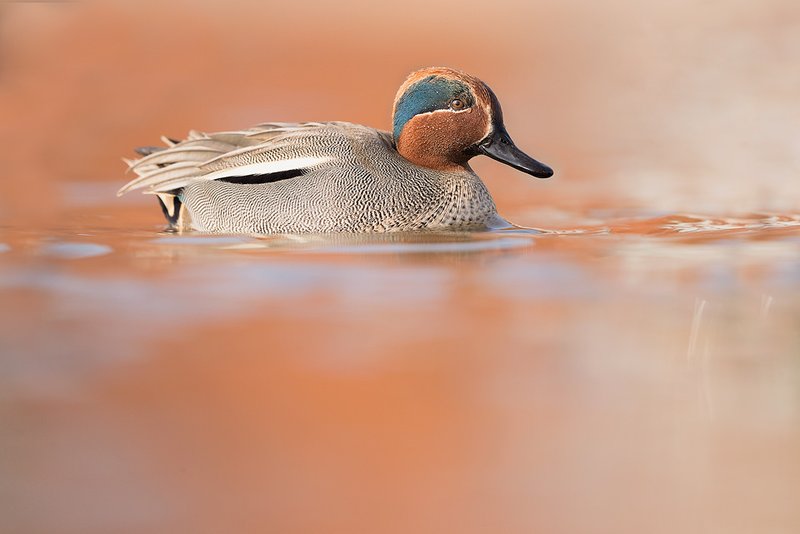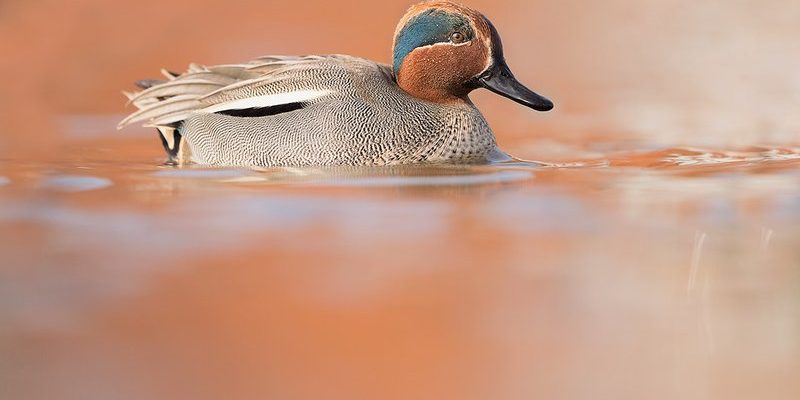
Teal is a fascinating color that sits comfortably between blue and green on the color wheel. It’s one of those colors that can evoke feelings of calmness and tranquility, much like a peaceful lake at dawn. When you think of teal, you might picture the vibrant shades of tropical oceans or the gentle hues of a serene forest. The color has a rich history and meaning, often associated with renewal, creativity, and emotional balance.
Interestingly, teal doesn’t just exist as a color; it’s also used to describe a variety of wild ducks belonging to the genus Anas. These birds, known for their striking plumage and adaptability, are found in many habitats across the globe. If you’ve ever admired the beauty of a duck gliding across a pond, you might have come across one of these delightful creatures. So, let’s dive deeper into what makes teal such an intriguing subject!
Teal in Nature
The Color Teal
Teal is characterized by a medium to deep blue-green color. It gets its name from the common teal, a duck species that displays a similarly colored stripe on its head. This color can take on different variations, from lighter shades like turquoise to darker shades that lean towards deep ocean hues. It’s often used in design and fashion for its versatility, blending well with other colors like coral, mustard, or even gold.
In nature, teal often appears in tropical plants and flowers, where it can create striking visual contrasts. Imagine a vibrant teal plant nestled among bright pink blooms; the effect can be absolutely stunning! The duality of blue and green in teal embodies a soothing yet energetic quality, making it popular in interior design, where it’s often used to create a calm atmosphere.
Teal Ducks
When talking about teal as a bird, we typically refer to several species of ducks. The most well-known include the Green-winged Teal and the Blue-winged Teal. These ducks are not only beautiful but also demonstrate incredible adaptability. They thrive in various environments, from wetlands and marshes to lakes and rivers. Their ability to adjust to different habitats showcases the resilience of wildlife.
Teal ducks are fascinating to watch, especially during migration periods when they flock in large groups. Their vibrant plumage, especially in males, makes them stand out, but they can also display remarkable camouflage with their muted tones when necessary. This adaptation is crucial for their survival, as it helps them evade predators.
Characteristics of Teal Ducks
| Species | Size | Habitat | Diet | Average Lifespan |
|---|---|---|---|---|
| Green-winged Teal | 12-14 inches | Wetlands, marshes | Seeds, aquatic plants, invertebrates | 2-3 years |
| Blue-winged Teal | 12-15 inches | Lakes, ponds, marshes | Seeds, insects | 3-5 years |
Behavior and Migration
Teal ducks are known for their agile flight and unique behavior, especially during migration. Most species migrate long distances to find suitable breeding and feeding grounds. It’s a breathtaking sight to see thousands of teal ducks take off in unison, creating a symphony of quacks and flapping wings. These migrations usually occur in the fall and spring, with flocks often flying in a distinctive V-shape.
During the breeding season, males display vibrant plumage to attract females. Interestingly, teal have a variety of calls that they use to communicate with one another. Their quacking, whistling, and grunting add to the lively atmosphere of their habitat, especially during the mating season.
Teal and Conservation
Like many wildlife species, teal ducks face threats from habitat loss and environmental changes. Wetland draining for agriculture and urban development has significantly impacted their populations. Conservation efforts are crucial to ensure these stunning creatures continue to thrive. Many organizations work to restore wetlands and protect migratory paths, helping to maintain the delicate balance of ecosystems.
As a part of the waterfowl family, teal ducks serve significant ecological roles, from controlling insect populations to aiding in seed dispersal. Protecting them isn’t just about saving a pretty bird; it’s about preserving the health of our whole environment.
Teal in Culture
Symbolism of Teal
In different cultures, teal often symbolizes balance and harmony. It can represent emotional healing and renewal, embodying the water element’s soothing properties. Artists and designers frequently use teal to evoke feelings of peace and relaxation, making it a popular choice in spas and wellness centers.
Moreover, teal has found its way into fashion, with designers using the color to create fresh, vibrant looks that stand out yet remain soothing. It’s versatile, working well in both casual wear and formal attire, which adds to its appeal.
Teal in Art and Design
Artists have long been inspired by the color teal. Its unique qualities make it an excellent choice for creating depth and intrigue in paintings and décor. Whether it’s a soothing teal landscape or a bold piece featuring vibrant teal patterns, you can evoke strong emotions and atmosphere through this color. Designers often pair teal with warm colors to create striking contrasts that captivate viewers’ attention.
In modern design, teal is frequently used in branding to convey creativity and innovation. Many tech companies incorporate teal into their logos and marketing materials, associating the color with modernity and forward-thinking. This makes teal not just a color but a statement of identity.
FAQ
What are the different shades of teal?
Teal comes in many shades, ranging from pale teal and light turquoise to deeper hues like dark teal and bluish-green. Each shade has its unique qualities and can evoke different emotions. For example, lighter shades often feel calming and refreshing, while darker shades can provide a sense of depth and sophistication.
Where can I find teal ducks?
Teal ducks can be found in a variety of locations, primarily in wetlands, marshes, and shallow lakes. They are widely distributed across North America, Europe, and parts of Asia. During migration seasons, you might spot them in larger bodies of water, where they gather in flocks for safety and companionship.
Are teal ducks good for hunting?
Yes, teal ducks are popular among waterfowl hunters due to their abundance and fast flight. Hunters often appreciate the challenge they present, as they can be quite agile and difficult to catch. It’s important to follow local regulations and participate in sustainable hunting practices to preserve their populations.
What do teal ducks eat?
Teal ducks primarily feed on seeds, aquatic plants, and small invertebrates. Their diet can change seasonally based on food availability. During the warmer months, they tend to consume more insects and plants, while they rely on seeds during colder months when food sources are limited.
How can I help conserve teal populations?
You can contribute to teal conservation by supporting wetland preservation efforts and participating in local environmental initiatives. Educating others about the importance of protecting these habitats and responsible wildlife management can also make a significant impact on the sustainability of teal populations.
Do teal ducks migrate?
Yes, teal ducks are migratory birds. They generally migrate south for the winter and north for breeding in the spring. Their migration patterns can vary by species, with some traveling long distances while others may just move to nearby areas for the season.
What is the lifespan of a teal duck?
The lifespan of teal ducks can vary by species, but on average, they live between 2 to 5 years in the wild. Factors such as predation, habitat conditions, and food availability can affect their lifespan. In protected environments, some teal may live longer, reaching up to 10 years with proper care.
How can I identify a teal duck?
To identify a teal duck, look for their small size, distinctive color patterns, and markings. Male teal ducks, especially during mating season, display vibrant plumage with striking colors. The Green-winged Teal has a characteristic green stripe on its head, while the Blue-winged Teal features a blue patch on its wing, making them easier to spot in the wild.
Are teal ducks social birds?
Yes, teal ducks are quite social, often found in groups or flocks. They communicate with one another through a range of calls and sounds, especially during the breeding season. Their social behavior aids in finding food, protecting against predators, and navigating migratory routes together.
What role do teal play in their ecosystem?
Teal ducks play an important role in their ecosystems by controlling insect populations, spreading plant seeds, and contributing to nutrient cycling in wetland habitats. Their feeding habits help maintain healthy aquatic environments, which are crucial for other wildlife species.
Can teal ducks adapt to urban environments?
While teal ducks prefer natural habitats, they can adapt to urban environments where water sources are available, like parks or ponds. However, they may face challenges such as pollution and habitat degradation, making conservation efforts essential to ensure their survival in these areas.

